An Effective Electrodeposition Mode for Porous MnO2/Ni Foam Composite for Asymmetric Supercapacitors
Abstract
:1. Introduction
2. Experimental Section
2.1. Preparation of MnO2/Ni Foam Composites
2.2. Sample Characterization
2.3. Electrochemical Measurements of Single Electrode and Asymmetric Supercapacitor
3. Results and Discussion
3.1. Sample Characterization
3.1.1. Structure Analysis
3.1.2. SEM Characterization of Electrodes
3.1.3. Porosity and Surface Area Characterization
3.2. Electrochemical Performances of MnO2/Ni Single Electrode
3.3. Electrochemical Performance of AC/(MnO2/Ni) Asymmetric Supercapacitor Devices
4. Conclusions
Acknowledgments
Author Contributions
Conflicts of Interest
References
- Yun, Y.S.; Park, H.H.; Jin, H.J. Pseudocapacitive effects of N-doped carbon nanotube electrodes in supercapacitors. Materials 2012, 5, 1258–1266. [Google Scholar] [CrossRef]
- Lee, H.M.; Lee, K.; Kim, C.K. Electrodeposition of Manganese-Nickel Oxide Films on a Graphite Sheet for Electrochemical Capacitor Applications. Materials 2014, 7, 265–274. [Google Scholar] [CrossRef]
- Liu, W.J.; Dai, Y.M.; Jehng, J.M. Synthesis, characterization and electrochemical properties of Fe/MnO2 nanoparticles prepared by using sol-gel reaction. J. Taiwan Inst. Chem. Eng. 2014, 45, 475–480. [Google Scholar] [CrossRef]
- Li, S.M.; Wang, Y.S.; Yang, S.Y.; Liu, C.H.; Chang, K.H.; Tien, H.W.; Wen, N.T.; Ma, C.C.; Hu, C.C. Electrochemical deposition of nanostructured manganese oxide on hierarchically porous graphene carbon nanotube structure for ultrahigh-performance electrochemical capacitors. J. Power Sources 2013, 225, 347–355. [Google Scholar] [CrossRef]
- Chou, S.L.; Wang, J.Z.; Chew, S.Y.; Liu, H.K.; Dou, S.X. Electrodeposition of MnO2 nanowires on carbon nanotube paper as free-standing, flexible electrode for supercapacitors. Electrochem. Commun. 2008, 10, 1724–1727. [Google Scholar] [CrossRef]
- West, W.C.; Myung, N.V.; Whitacre, J.F.; Ratnakumar, B.V. Electrodeposited amorphous manganese oxide nanowire arrays for high energy and power density electrodes. J. Power Sources 2004, 126, 203–206. [Google Scholar] [CrossRef]
- Yousefi, T.; Golikand, A.N.; Mashhadizadeh, M.H.; Mustafa, A. Facile synthesis of α-MnO2 one-dimensional (1D) nanostructure and energy storage ability studies. J. Solid State Chem. 2012, 190, 202–207. [Google Scholar] [CrossRef]
- Chen, Y.C.; Hsu, Y.K.; Lin, Y.G.; Lin, Y.K.; Horng, Y.Y.; Chen, L.C.; Chen, K.H. Highly flexible supercapacitors with manganese oxide nanosheet/carbon cloth electrode. J. Electrochim. Acta 2011, 56, 7124–7130. [Google Scholar] [CrossRef]
- Hassan, S.; Suzuki, M.; El-Moneim, A.A. Capacitive Behavior of Manganese Dioxide/Stainless Steel Electrodes at Different Deposition Currents. J. Power Sources 2012, 2, 11–14. [Google Scholar] [CrossRef]
- Zhao, D.; Yang, Z.; Zhang, L.; Feng, X.; Zhang, Y. Electrodeposited Manganese Oxide on Nickel Foam-Supported Carbon Nanotubes for Electrode of Supercapacitors. J. Electrochem. Solid State Lett. 2011, 14, A93–A96. [Google Scholar] [CrossRef]
- Aravindan, V.; Reddy, M.V.; Madhavi, S.; Mhaisalkar, S.G.; Subba Raob, G.V.; Chowdari, B.V.R. Hybrid supercapacitor with nano-TiP2O7 as intercalation electrode. J. Power Sources 2011, 196, 8850–8854. [Google Scholar] [CrossRef]
- Wua, Y.; Balakrishnaa, R.; Reddy, M.V.; Naira, A.S.; Chowdari, B.V.R.; Ramakrishna, S. Functional properties of electrospun NiO/RuO2 composite carbon nanofibers. J. Alloys Compd. 2012, 517, 69–74. [Google Scholar] [CrossRef]
- Aravindan, V.; Chuiling, W.; Reddy, M.V.; Subba Rao, G.V.; Chowdari, B.V.R.; Madhavi, S. Carbon coated nano-LiTi2(PO4)3 electrodes for non-aqueous hybrid supercapacitors. Phys. Chem. Chem. Phys. 2012, 14, 5808–5814. [Google Scholar] [CrossRef] [PubMed]
- Reddy, M.V.; Jose, R.; Le Viet, A.; Ozoemena, K.I.; Chowdari, B.V.R.; Ramakrishna, S. Studies on the lithium ion diffusion coefficients of electrospun Nb2O5 nanostructures using galvanostatic intermittent titration andelectrochemical impedance spectroscopy. Electrochim. Acta 2014, 128, 198–202. [Google Scholar] [CrossRef]
- Das, B.; Behm, M.; Lindbergh, G.; Reddy, M.V.; Chowdari, B.V.R. High performance metal nitrides, MN (M = Cr, Co) nanoparticles fornon-aqueous hybrid supercapacitors. Adv. Powder Technol. 2015, 26, 783–788. [Google Scholar] [CrossRef]
- Krishnan, S.G.; Reddy, M.V.; Harilal, M.; Vidyadharan, B.; Misnon, I.I.; Ab Rahim, M.H.; Ismail, J.; Jose, R. Characterization of MgCo2O4 as an electrode for high performance supercapacitors. Electrochim. Acta 2015, 161, 312–321. [Google Scholar] [CrossRef]
- Arise, I.; Kawai, S.; Fukunaka, Y.; McLarnon, F.R. Numerical Calculation of Ionic Mass-Transfer Rates Accompanying Anodic Zinc Dissolution in Alkaline Solution. J. Electrochem. Soc. 2010, 157, A171–A178. [Google Scholar] [CrossRef]
- Aravindan, V.; Reddy, M.V.; Madhavi, S.; Rao, G.V.; Subba; Chowdari, B.V.R. Electrochemical Performance of α-MnO2 Nanorods/Activated Carbon Hybrid Supercapacitor. Nanosci. Nanotechnol. Lett. 2012, 4, 724–728. [Google Scholar] [CrossRef]
- Reddy, M.V.; Subba Rao, G.V.; Chowdari, B.V.R. Metal Oxides and Oxysalts as Anode Materials for Li Ion Batteries. Chem. Rev. 2013, 113, 5364–5457. [Google Scholar]
- Lin, Y.P.; Wu, N.L. Characterization of MnFe2O4/LiMn2O4 aqueous asymmetric Supercapacitor. J. Power Sources 2011, 196, 851–854. [Google Scholar] [CrossRef]
- Kundu, M.; Liu, L. Direct growth of mesoporous MnO2 nanosheet arrays on nickel foam current collectors for high-performance pseudocapacitors. J. Power Sources 2013, 243, 676–681. [Google Scholar] [CrossRef]
- Yousefi, T.; Golikand, A.N.; Mashhadizadeh, M.H.; Aghazadeh, M. Template-free synthesis of MnO2 nanowires with secondary flower like structure: Characterization and supercapacitor behavior studies. J. Curr. Appl. Phys. 2012, 12, 193–198. [Google Scholar] [CrossRef]
- Lva, P.; Zhanga, P.; Feng, Y.; Li, Y.; Feng, W. High-performance electrochemical capacitors using electrodeposited MnO2 on carbon nanotube array grown on carbon fabric. J. Electrochim. Acta 2012, 78, 515–523. [Google Scholar] [CrossRef]
- Zhang, P.; Li, K.; Liu, X. Carnation-like MnO2 modified activated carbon air cathode improve power generation in microbial fuel cells. J. Power Sources 2014, 264, 248–253. [Google Scholar] [CrossRef]
- Ding, K.Q. Cyclic voltammetrically-prepared MnO2 coated on an ITO glass substrate. J. Chin. Chem. Soc. 2009, 56, 175–181. [Google Scholar] [CrossRef]
- Babakhani, B.; Ivey, D.G. Effect of electrodeposition conditions on the electrochemical capacitive behavior of synthesized manganese oxide electrodes. J. Power Sources 2011, 196, 10762–10774. [Google Scholar] [CrossRef]
- Kuo, S.L.; Wu, N.L. Investigation of Pseudocapacitive Charge-Storage Reaction of MnO2·H2O Supercapacitors in Aqueous Electrolytes. J. Electrochem. Soc. 2006, 153, A1317–A1324. [Google Scholar] [CrossRef]
- Athoüel, L.; Moser, F.; Dugas, R.; Crosnier, O.; B’elanger, D.; Brousse, T. Variation of the MnO2 Birnessite structure upon Charge/Discharge in an Electrochemical Supercapacitor Electrode in Aqueous Na2SO4 Electrolyte. J. Phys. Chem. 2008, 112, 7270–7277. [Google Scholar]
- Dubal, D.P.; Dhawale, D.S.; Gujar, T.P.; Lokhande, C.D. Effect of different modes of electrodeposition on supercapacitive properties of MnO2 thin films. Appl. Surf. Sci. 2011, 257, 3378–3382. [Google Scholar] [CrossRef]
- Yang, J.; Liana, L.F.; Ruana, H.C.; Xie, F.Y.; Wei, M.D. Nanostructured porous MnO2 on Ni foam substrate with a high mass loading via a CV electrodeposition route for supercapacitor application. J. Electrochim. Acta 2014, 136, 189–194. [Google Scholar] [CrossRef]
- Mele, C.; Catalano, M.; Taurino, A.; Bozzini, B. Electrochemical fabrication of nanoporous gold-supported manganese oxide nanowires based on electrodeposition from eutectic urea/choline chloride ionic liquid. J. Electrochim. Acta 2013, 87, 918–924. [Google Scholar] [CrossRef]
- Therese, G.H.A.; Kamath, P.V. Electrochemical Synthesis of Metal Oxides and Hydroxides. Chem. Mater. 2000, 12, 1195–1204. [Google Scholar] [CrossRef]
- Peng, P.Y.; Jin, I.; Yang, C.K.; Huang, C.M. Facile preparation of hierarchical CuO-CeO2/Ni metal foam composite for preferential oxidation of CO in hydrogen-rich gas. Chem. Eng. J. 2014, 251, 228–235. [Google Scholar] [CrossRef]
- Ettireddy, P.R.; Ettireddy, N.; Mamedov, S.; Boolchand, P.; Smirniotis, P.G. Surface characterization studies of TiO2 supported manganese oxide catalysts for low temperature SCR of NO with NH3. Appl. Catal. B 2007, 76, 123–134. [Google Scholar] [CrossRef]
- Kruk, M.; Jaroniec, M. Gas adsorption characterization of ordered organic-inorganic nanocomposite materials. Chem. Mater. 2001, 13, 3169–3183. [Google Scholar] [CrossRef]
- Hao, P.; Zhao, Z.; Tian, J.; Li, H.; Sang, Y.; Yu, G.; Cai, H.; Liu, H.; Wong, C.P.; Umar, A. Hierarchical porous carbon aerogel derived from bagasse for high performance supercapacitor electrode. Nanoscale 2014, 6, 12120–12129. [Google Scholar] [CrossRef] [PubMed]
- Simon, P.; Gogotsi, Y. Materials for electrochemical capacitors. Nat. Mater. 2008, 7, 845–854. [Google Scholar] [CrossRef] [PubMed]
- Gund, G.S.; Dubal, D.P.; Patil, B.H.; Shinde, S.S.; Lokhande, C.D. Enhanced activity of chemically synthesized hybrid graphene oxide/Mn3O4 composite for high performance supercapacitors. Electrochim. Acta 2013, 92, 205–215. [Google Scholar] [CrossRef]
- Asuka, F.; Satoko, E.; Mitsuhiko, E.; Naohiko, M. Morphology of Protonated Methanol Clusters: An Infrared Spectroscopic Study of Hydrogen Bond Networks of H+(CH3OH)n (n = 4–15). J. Phys. Chem. B 2015, 109, 138–141. [Google Scholar]
- Goodenough, J.B.; Lee, H.Y. Supercapacitor Behavior with KCl Electrolyte. J. Solid State Chem. 1999, 144, 220–223. [Google Scholar]
- Wang, Z.; Li, Z.; Feng, J.; Yan, S.; Luo, W.; Liu, J.; Yu, L.; Zou, Z. MnO2 nanolayers on highly conductive TiO0.54N0.46 nanotubes for supercapacitor electrodes with high power density and cyclic stability. Phys. Chem. Chem. Phys. 2014, 16, 8521–8528. [Google Scholar] [CrossRef] [PubMed]
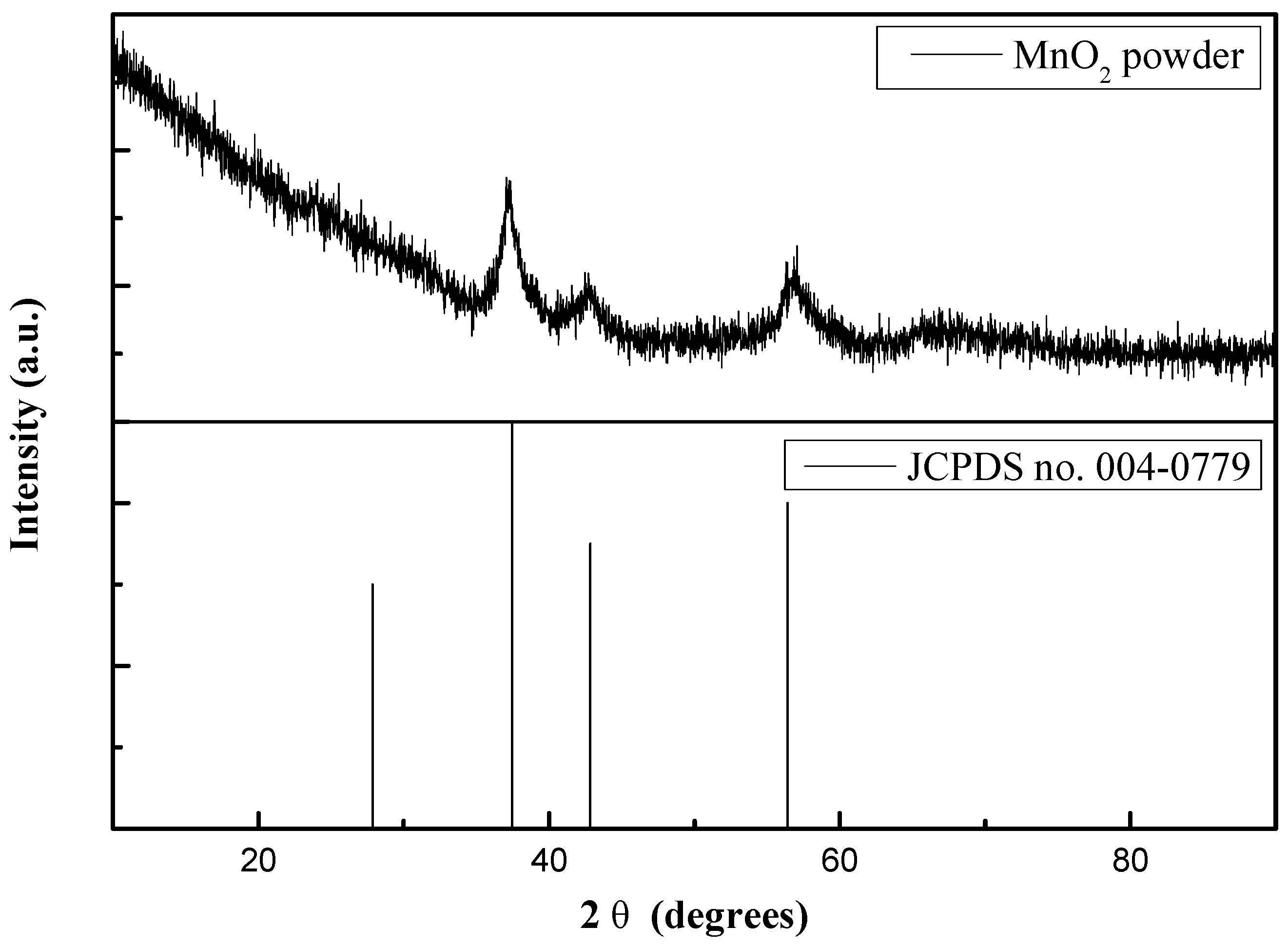
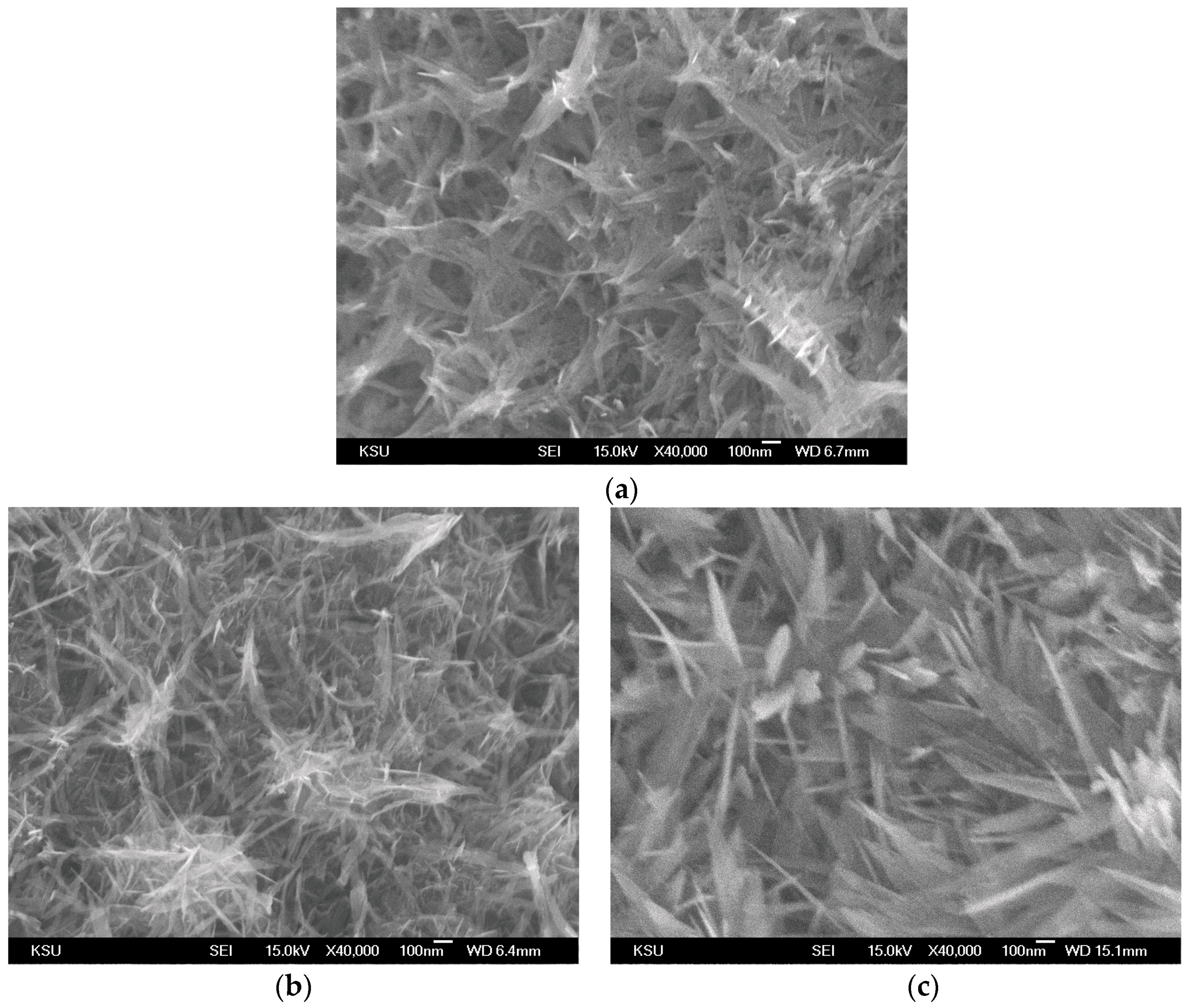
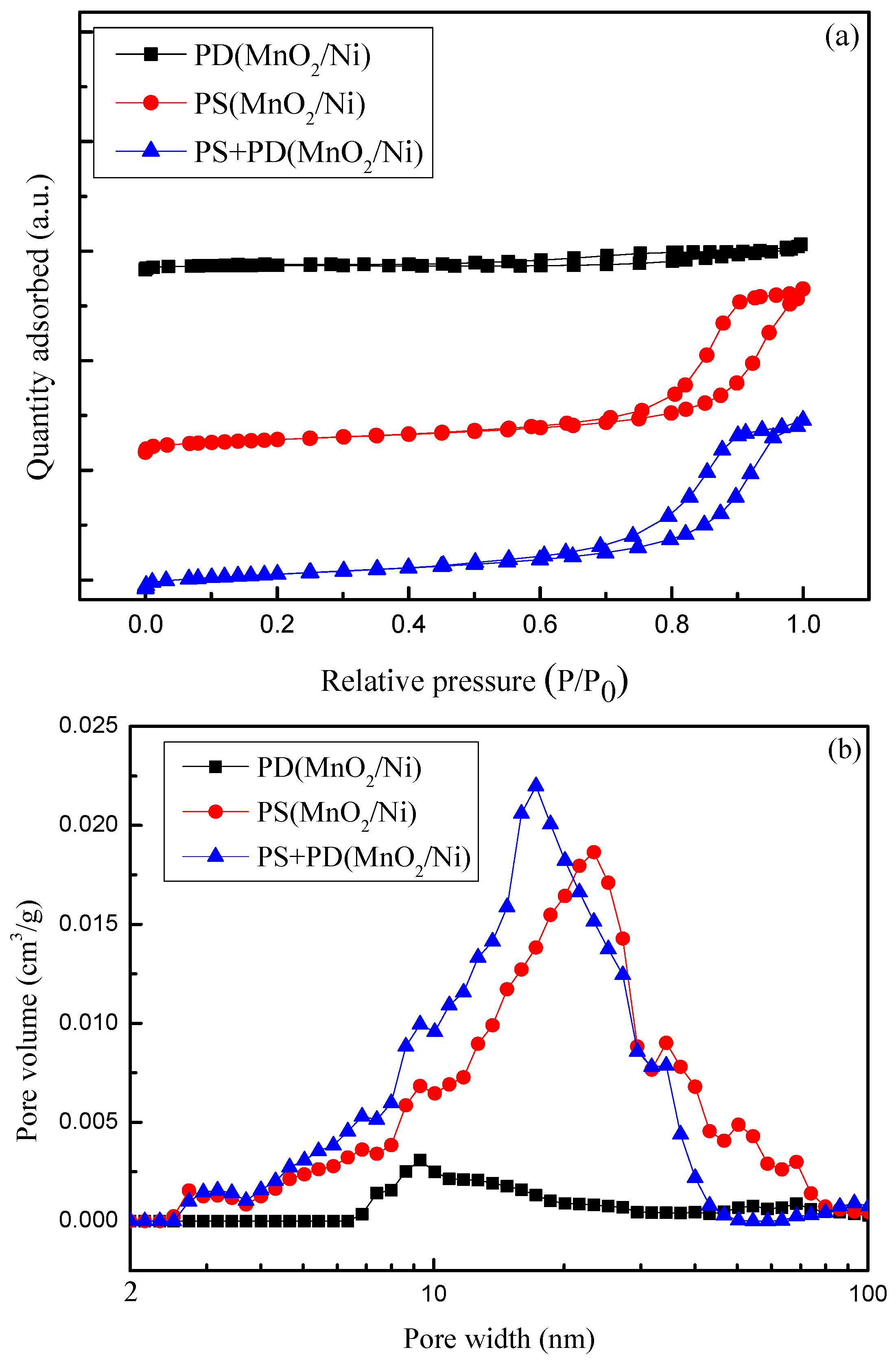
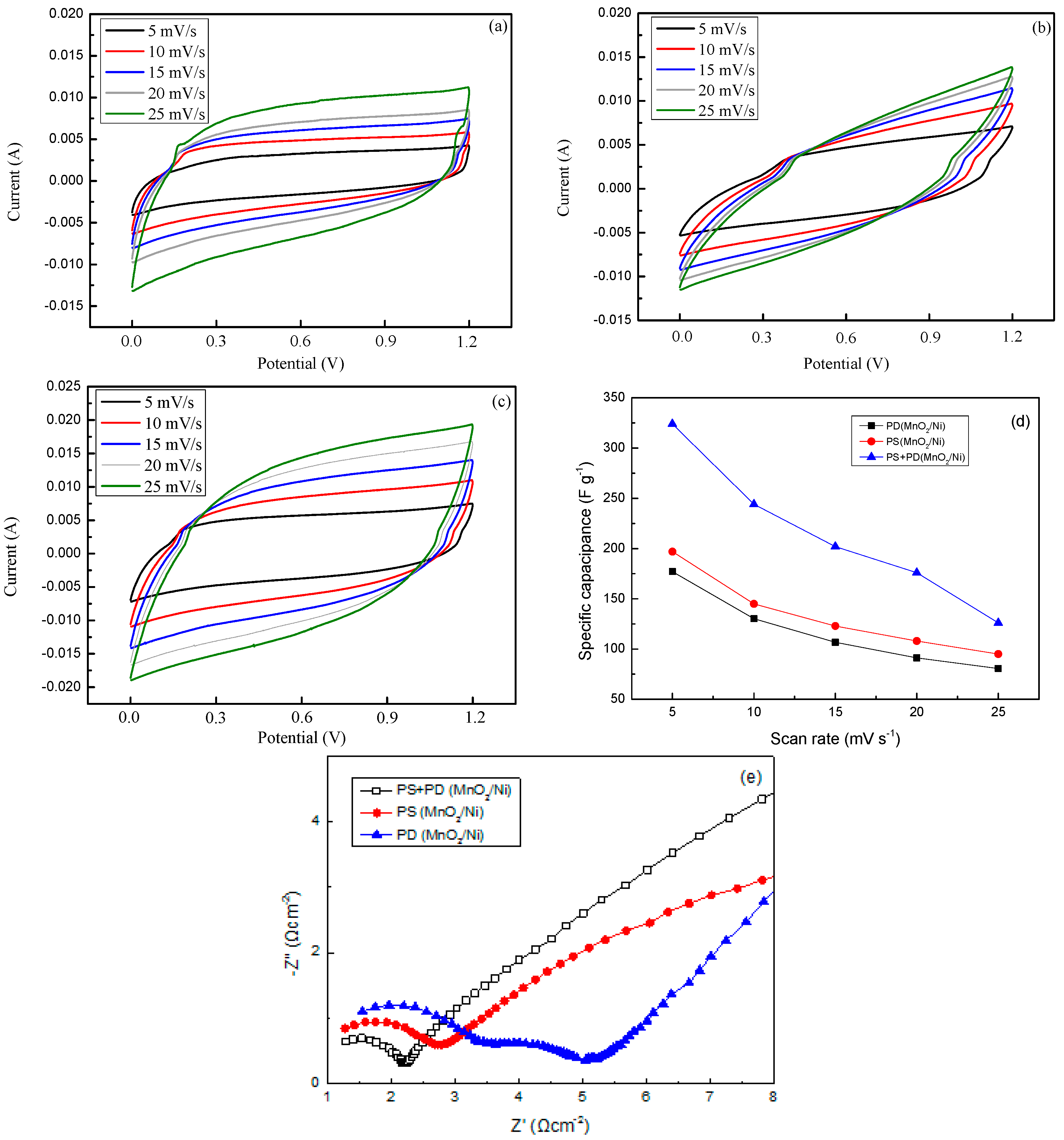
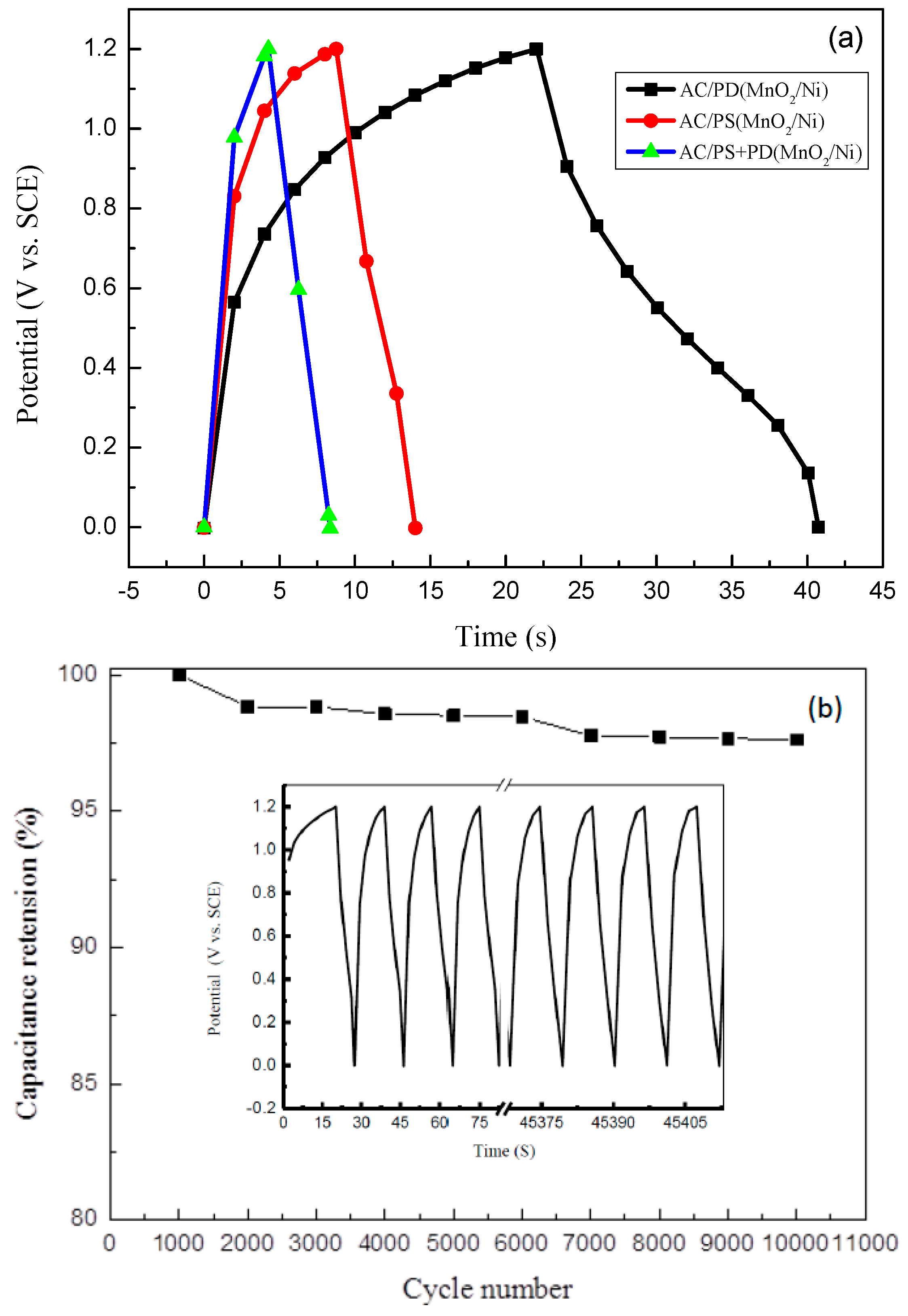
| Sample | SBET (m2·g−1) | Vpore (cm3·g−1) | Dp (nm) |
|---|---|---|---|
| PD(MnO2/Ni) | 21 | 0.04 | 8 |
| PS(MnO2/Ni) | 86 | 0.30 | 14 |
| PS + PD(MnO2/Ni) | 103 | 0.34 | 13 |
| Asymmetric Supercapacitor | Specific Energy Density (Wh·kg−1) | Specific Power Density (W·kg−1) |
|---|---|---|
| AC/PD(MnO2/Ni) | 0.78 | 700 |
| AC/PS(MnO2/Ni) | 1.00 | 679 |
| AC/PS + PD(MnO2/Ni) | 9.05 | 708 |
© 2016 by the authors; licensee MDPI, Basel, Switzerland. This article is an open access article distributed under the terms and conditions of the Creative Commons by Attribution (CC-BY) license (http://creativecommons.org/licenses/by/4.0/).
Share and Cite
Tsai, Y.-C.; Yang, W.-D.; Lee, K.-C.; Huang, C.-M. An Effective Electrodeposition Mode for Porous MnO2/Ni Foam Composite for Asymmetric Supercapacitors. Materials 2016, 9, 246. https://doi.org/10.3390/ma9040246
Tsai Y-C, Yang W-D, Lee K-C, Huang C-M. An Effective Electrodeposition Mode for Porous MnO2/Ni Foam Composite for Asymmetric Supercapacitors. Materials. 2016; 9(4):246. https://doi.org/10.3390/ma9040246
Chicago/Turabian StyleTsai, Yi-Chiun, Wein-Duo Yang, Kuan-Ching Lee, and Chao-Ming Huang. 2016. "An Effective Electrodeposition Mode for Porous MnO2/Ni Foam Composite for Asymmetric Supercapacitors" Materials 9, no. 4: 246. https://doi.org/10.3390/ma9040246
APA StyleTsai, Y.-C., Yang, W.-D., Lee, K.-C., & Huang, C.-M. (2016). An Effective Electrodeposition Mode for Porous MnO2/Ni Foam Composite for Asymmetric Supercapacitors. Materials, 9(4), 246. https://doi.org/10.3390/ma9040246







